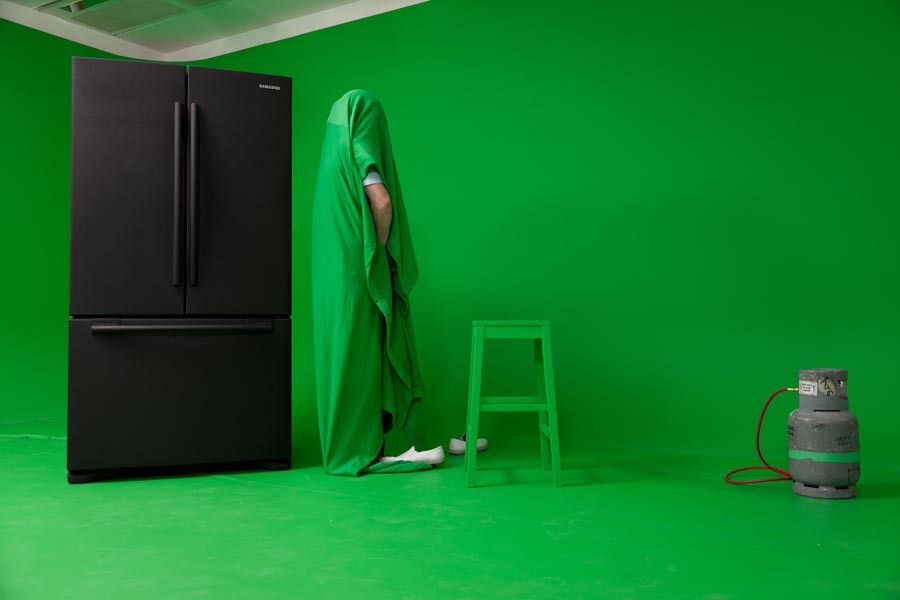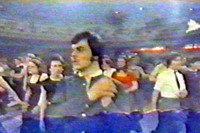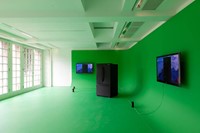This month The Serpentine Gallery presents a new exhibition conceived by 2008 Turner Prize winner Mark Leckey, SEE, WE ASSEMBLE. His first UK solo show exhibits three of his major works – BigBoxStatueAction, Fiorucci Made Me Hardcore and
This month The Serpentine Gallery presents a new exhibition conceived by 2008 Turner Prize winner Mark Leckey, SEE, WE ASSEMBLE. His first UK solo show exhibits three of his major works – BigBoxStatueAction, Fiorucci Made Me Hardcore and GreenScreenRefrigerator. Encompassing sculpture, sound, film and performance, Leckey comments on aspects of British culture that affect his daily life as well as revisiting themes of progression and desire. For BigBoxStatueAction (2003–11) Leckey places one of his ‘Sound Systems’ – and for four evenings live performances – in conversation with a Henry Moore sculpture in an attempt to coax it into revealing its thoughts. His seminal 1999 video work, Fiorucci Made Me Hardcore, explores the history of underground dance culture in the UK from the mid-1970s to early 1990s. And Leckey’s most recent performance piece, GreenScreenRefrigerator (2010), sees the artist in conversation with the inner life of a ‘smart’ fridge – examining modern technology and the notion that we can be in continuous communication with every part of our environment. On the day of the show opening, AnOther spoke to the artist about his practice and works on show.
A multi-disciplinary artist and a commentator of British culture - how would you describe what you do?
I hate that phrase ‘multi-disciplinary’... Pwoarh. That’s difficult. Can we start with another one?
Your current show at the Serpentine has three very different but connecting works. Can you explain your intentions behind the show and why these three particular pieces?
Fiorucci Made Me Hardcore is the oldest one; it’s from ten years ago. Not only an old work, but at the time that I made it it was about the past – it’s kind of a nostalgic piece. The new fridge piece, is kind of about the future – the present. And then the piece in the middle of the gallery, BigBoxStatueAction, is about the past – Henry Moore, meeting the present with the live performances.
The other thing that binds them together is that they are three brands that have had some influence or effect on me. Fiorucci was a label that I wore in my youth, when I was a ‘casual’. Fiorucci was this Italian label that was really desirable. Henry Moore is this ‘name’ in British art, he’s like a father figure but not taken seriously anymore, I guess. And then Samsung is the alternative Apple... I mean I’m speaking to you now on a Samsung phone, I’ve got Samsung appliances all around the house. These are things I live with every day, and so all these things are things that I’ve lived through or lived with. They’re all things that I’ve had a direct relationship with.
Would you say that they were a reflection of you in a sense?
Yes definitely. I don’t think it’s autobiographical, I just think I’m making work about things that I know and that I’m experiencing, and that whatever I’m experiencing at the time, that’s what I make work from. It’s whatever is in my immediate environment that’s having the greatest effect on me. So at the moment the thing that I notice most about the world is technology and how that’s transforming everything.
I find Fiorucci one of your most captivating pieces and despite being made in 2009 it continues to draw a lot of attention. What do you think sustains its popularity?
I think because it’s about people dancing in Britain from the mid-1970s to the early 1990s. Not only because we live in Britain but also because we’re at a very nostalgic stage in our existence and we’re obsessed with images of past days – I think that’s what the film’s about. I don’t think the film’s about dancing or youth culture, I think it’s just about how images from the past have an effect on you, and can give you this really sickening sense of nostalgia...kind of painful.
Found footage, film and video dominates a lot of your work. Why do you find it is an important medium for you?
I think because it’s what’s at hand. I’m surrounded by this stuff; it’s accessible. If I was making sculpture I’d use the materials that are around you, this stuff’s there to be used. And then also that’s my background: I grew up with jungle and rave, and sampling culture. That’s what I ‘do’ – basically I just use samples of things. Samples have this power, they have an innate power, when you hear something that’s familiar, it triggers something.
Your series of live performances at the Serpentine as part of BigBoxStatueAction start 26 May – are you looking forward to them?
No. (Laughs). No seriously, I am. Actually they’ve just turned up now, the people I’m going to be doing it with this band called Jack Too Jack, they are going to do one or two of the live performances as part of BigBoxStatueAction.
Finally can I ask you what you do again?
I try and respond to the world that I live in, using the stuff that surrounds me.
Mark Leckey, SEE, WE ASSEMBLE runs until 26 June at The Serpentine Gallery.
Text by Lucia Davies



